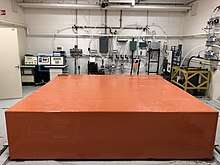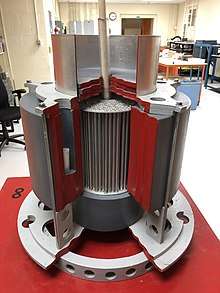SLOWPOKE reactor
The SLOWPOKE (acronym for Safe LOW-POwer Kritical Experiment) is a low-energy, tank-in-pool type nuclear research reactor designed by Atomic Energy of Canada Limited (AECL) in the late 1960s. John W. Hilborn is the scientist most closely associated with its design. It is beryllium-reflected with a very low critical mass but provides neutron fluxes higher than available from a small particle accelerator or other radioactive sources.
| SLOWPOKE reactor | |
|---|---|
 Polytechnique Montreal's SLOWPOKE-2 reactor pit cover. | |
| Generation | Neutron |
| Reactor concept | Low-energy, tank-in-pool type nuclear research reactor |
| Main parameters of the reactor core | |
| Fuel (fissile material) | Information missing |
| Primary coolant | Light-water |
| Reactor usage | |
| Primary use | Neutron activation analysis |
Basic design

The SLOWPOKE-2 originally used 93% highly enriched uranium in the form of 28% uranium-aluminium alloy with aluminium cladding, and then in 1985 a new low enriched uranium design (~19.9 % enriched) was commissioned using ceramic UO2 fuel. The core is an assembly of about 200-300 fuel pins, only 22 cm diameter and 23 cm high, surrounded by a fixed beryllium annulus and a bottom beryllium slab. Criticality is maintained as the fuel burns up by adding beryllium plates in a tray on top of the core. The reactor core sits in a pool of regular light-water, 2.5 m diameter by 6 m deep, which provides cooling via natural convection. In addition to passive cooling, the reactor has a high degree of inherent safety; that is, it can regulate itself through passive, natural means, such as the chain reaction slowing down if the water heats up or forms bubbles. These characteristics are so dominant, in fact, that the SLOWPOKE-2 reactor is licensed to operate unattended overnight (but monitored remotely). Most SLOWPOKES are rated at a nominal 20 kW, although operation at higher power for shorter durations is possible.
History
SLOWPOKE-1 and SLOWPOKE-2
The SLOWPOKE research reactor was conceived in 1967 at the Whiteshell Laboratories of AECL. In 1970 a prototype unit was designed and built at Chalk River Laboratories. It was primarily intended for Canadian universities, providing a higher neutron flux than available from small commercial accelerators, while avoiding the complexity and high operating costs of existing nuclear reactors. The Chalk River prototype went critical in 1970, and was moved to the University of Toronto in 1971. It had one sample site in the beryllium reflector and operated at a power level of 5 kW. In 1973 the power was increased to 20 kW and the period of unattended operation was increased from 4 hours to 18 hours.
The first commercial example was started up in 1971 at AECL's Commercial Products Division in Ottawa; and in 1976 a commercial design, named SLOWPOKE-2, was installed at the University of Toronto, replacing the original SLOWPOKE-1 unit. The commercial model has five sample sites in the beryllium reflector and five sites stationed outside the reflector.
Between 1976 and 1984, seven SLOWPOKE-2 reactors with Highly Enriched Uranium (HEU) fuel were commissioned in six Canadian cities and in Kingston, Jamaica. In 1985 the first Low-Enriched Uranium (LEU) fuelled SLOWPOKE-2 reactor was commissioned at the Royal Military College of Canada (RMC) in Kingston, Ontario. Since then five reactors have been decommissioned (Saskatchewan Research Council, University of Toronto, Alberta, Dalhousie, and Saskatchewan), and one converted to LEU (Polytechnique Montreal).
SLOWPOKE-3 and SLOWPOKE-4
AECL also designed and built a scaled-up version (2-10 MWth) called the SLOWPOKE Demonstration Reactor (SDR, "SLOWPOKE-3") for district heating at its Whiteshell Nuclear Research Establishment in Manitoba. The economics of a district-heating system based on SDR technology were estimated to be competitive with that of conventional fossil fuels. However, the market for this technology did not materialize, and the proposed SES-10 ("SLOWPOKE-4" based on SDR experience) was never built, and the SDR shutdown for decommissioning.
Marine Power Source
During the mid-1980s Canada briefly considered converting its Oberon class submarines to nuclear power using a SLOWPOKE nuclear reactor to continuously recharge the ship's batteries during submerged operations.[1] A good deal of work had been done on potential marine applications of the reactor at Royal Military College of Canada.
Current applications
SLOWPOKE reactors are used mainly for neutron activation analysis (NAA), in research and as a commercial service, but also for teaching, training, irradiation studies, neutron radiography (only at the Royal Military College of Canada), and the production of radioactive tracers. The main advantages are the reliability and ease of use of this design of reactor and the reproducibility of the neutron flux. Since the fuel is not modified at all for at least 20 years, the neutron spectrum in the irradiation sites does not change and the neutron flux is reproducible to about 1%.
Three of the original reactors are still in operation. Although all of the technical goals of this reactor were achieved, the lack of foreign sales was disappointing.
- Royal Military College of Canada's non-power reactor operating licence was renewed and will be valid from July 1, 2013 until June 30, 2023. RMCC has operated a small SLOWPOKE-2 research facility (nominal reactor power of 20 kW) since 1985. A Neutron Beam Tube (NBT) was added in February 1999 to the SLOWPOKE-2 facility for radioscopy and tomography operations (2-dimensional and 3-dimensional non-destructive imaging techniques).[2]
- École Polytechnique de Montréal's SLOWPOKE-2 non-power reactor operating licence was renewed and will be valid from July 1, 2013 until June 30, 2023. The reactor has been in operation for 36 years and is used for research, teaching, neutron generation and isotope production.[3]
- The University of the West Indies International Centre for Environmental and Nuclear Sciences in Kingston Jamaica continues to operate their SLOWPOKE-2 reactor, which has since been converted to LEU in 2017 through a partnership with the Office of Radiological Security (ORS) and the IAEA.
Former applications
- Dalhousie University applied for, and was issued, a Licence to de-fuel, and decommission the SLOWPOKE-2 Reactor Facility, which was part of Dalhousie’s Trace Analysis Research Centre. in Halifax, Nova Scotia on August 31, 2011.[4]
- The University of Toronto’s SLOWPOKE Reactor operated from 1976 until December 31, 1998. The University of Toronto applied for, and was issued, a Licence to Decommission its SLOWPOKE-2 Nuclear Research Reactor Facility in 2001.[5]
- University of Alberta’s SLOWPOKE-2 Reactor operated from April 22, 1977 until being dismantled on August 5, 2017. The University of Alberta applied for, and was issued a Licence to Decommission its SLOWPOKE-2 Nuclear Research Reactor Facility in 2017.[6][7]
- Saskatchewan Research Council's SLOWPOKE-2 Reactor operated from 1981, until being shut down in December 2017. Decommissioning is expected to be completed sometime in 2020.[8]
See also
References
- Julie H. Ferguson (10 March 2014). Through a Canadian Periscope: The Story of the Canadian Submarine Service. Dundurn. p. 363. ISBN 978-1-4597-1056-6.
- Royal Military College of Canada SLOWPOKE
- École Polytechnique de Montréal's SLOWPOKE-2
- Dalhousie University SLOWPOKE-2
- University of Toronto SLOWPOKE-2
- University of Alberta Public Information and Disclosure program
- University of Alberta’s SLOWPOKE-2
- Shield, David (4 January 2019). "'It was very unique': Saskatoon's SLOWPOKE-2 research reactor shutting down after 37 years". Canadian Broadcasting Corporation. Retrieved 29 November 2019.
- Whitlock:"Canadian Nuclear FAQ". The Canadian Nuclear FAQ by Dr. Jeremy Whitlock. Retrieved March 5, 2005.
- G. Kennedy and J. St. Pierre::"LEU-FUELLED SLOWPOKE-2 RESEARCH REACTORS: OPERATIONAL EXPERIENCE AND UTILISATION" (PDF). 2002 International Meeting on Reduced Enrichment for Research and Test Reactors. Retrieved October 1, 2005.
- La mort du projet SAGA-N par impôts fédéraux The death of the SAGA-N project by federal tax (English translation provided)
- Taking the Plunge: Should Canada Use Fuel Cell Technology to make the Victoria-class Submarines more Stealthy?
External links
- SLOWPOKE Reactor Facility of the University of Toronto
- University of Alberta SLOWPOKE Nuclear Reactor Facility
- The SLOWPOKE Laboratory École Polytechnique
- McMaster Nuclear Reactor
- Royal Military College of Canada SLOWPOKE-2 Nuclear Reactor and Facility
- Saskatchewan Research Council Analytical Laboratories and their SLOWPOKE FAQ
- Dalhousie University Department of Chemistry SLOWPOKE Nuclear Research Reactor
- Atomic Energy of Canada Limited
- Canadian Nuclear Safety Commission
- Canadian Nuclear Society
- Canadian Nuclear Association
- International Centre for Environmental and Nuclear Sciences, Jamaica